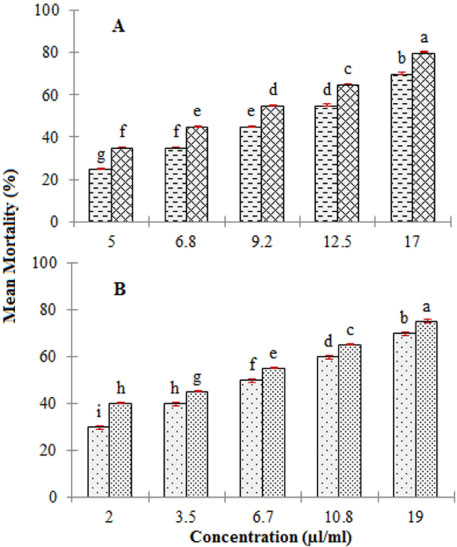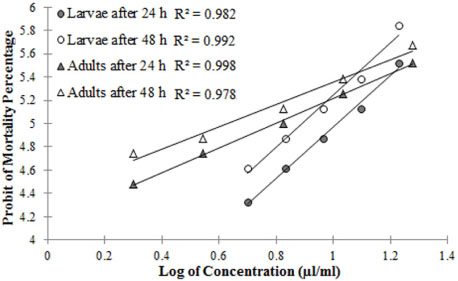Nat Prod Sci.
2017 Dec;23(4):235-238. 10.20307/nps.2017.23.4.235.
Colorado Potato Beetle (Leptinotarsa decemlineata Say) Control Potential of Essential Oil Isolated from Iranian Cymbopogon citratus Stapf
- Affiliations
-
- 1Moghan College of Agriculture and Natural Resources, University of Mohaghegh Ardabili, Ardabil 56971-94781, Iran. ebadollahi@uma.ac.ir
- 2Department of Plant Protection, Ardabil Branch, Ministry of Agriculture-Jihad, Ardabil 56169-14543, Iran.
- KMID: 2401573
- DOI: http://doi.org/10.20307/nps.2017.23.4.235
Abstract
- Colorado potato beetle is a most destructive insect pest of potato throughout the world. Although utilization of chemical insecticides is a main method for management of this pest, their negative side-effects such as threat to humans and the environmental pollution prompted researchers to search for natural alternatives. Recently plant essential oils with low or without side-effects against noun-targeted organisms and with high availability were considered as safe bio-pesticides. In the present study, toxicity of essential oil of Iranian lemongrass, Cymbopogon citratus Stapf, was evaluated against 3th instar larvae and adults of Colorado potato beetle by a leaf dipping method. Results displayed essential oil had notable toxicity against both larvae and adults after 24 and 48 h exposure times. Probit analysis revealed LCâ‚…â‚€ values (lethal concentration to kill 50% of population) with 95% confidence limits were 10.32 (9.17 - 11.72) and 7.76 (6.80 - 8.74) µl/ml for larvae and 6.27 (4.82 - 8.15) and 4.35 (3.24 - 5.62) µl/ml for adults after 24 and 48 h, respectively. Based on regression analysis, a positive correlation between log concentration of essential oil and insect mortality was achieved. Results indicated C. citratus essential oil can be candidate as a natural alternative to the harmful chemical insecticides in the management of Colorado potato beetle.
MeSH Terms
Figure
Reference
-
1. Malekmohammadi M. J Asia-Pacific Entomol. 2014; 17:213–220.2. Nouri-Ganbalani G. J Agri Sci. 1989; 29:1–9.3. Hare JD. Annu Rev Entomol. 1990; 35:81–100.4. Allahyari H, Fard PA, Talebi K. Res Pest Manag News. 2005; 14:13–15.5. Cutler GC, Tolman JH, Scott-Dupree CD, Harris CR. J Econ Entomol. 2005; 98:1685–1693.6. Mohammadi Sharif M, Hejazi MJ, Mohammadi A, Rashidi MR. J Insect Sci. 2007; 7:1–7.7. Alyokhin A, Baker M, Mota-Sanchez D, Dively G, Grafius E. Am J Pot Res. 2008; 85:395–413.8. Bakkali F, Averbeck S, Averbeck D, Idaomar M. Food Chem Toxicol. 2008; 46:446–475.9. Isman MB. Annu Rev Entomol. 2006; 51:45–66.10. Isman MB, Miresmailli S, Machial C. Phytochem Rev. 2011; 10:197–204.11. Isman MB, Grieneisen ML. Trends Plant Sci. 2014; 19:140–145.12. Ebadollahi A, Jalali-Sendi J. Toxin Rev. 2015; 34:76–91.13. Sousa SM, Silva PS, Viccini LF. An Acad Bras Cienc. 2010; 82:305–311.14. Tangpu V, Yadav AK. Pharmacologyonline. 2006; 48:290–298.15. Tzortzakis NG, Economakis CD. Innov Food Sci Emerg Technol. 2007; 8:253–258.16. Shah G, Shri R, Panchal V, Sharma N, Singh B, Mann AS. J Adv Pharm Technol Res. 2011; 2:3–8.17. Kordali S, Kesdek M, Cakir A. Ind Crops Prod. 2007; 26:278–297.18. Rechinger KH. Graz: Flora Iranica (Umbelliferae);Germany: Akademische Druck-u;1978. p. 130.19. Safaei-Khorram M, Jafarnia S, Khosroshahi S. J Plant Protect Res. 2011; 51:225–233.20. Taghizadeh Saroukolai A, Nouri-Ganbalani G, Rafiee-Dastjerdi H, Hadian J. Plant Protect Sci. 2014; 50:207–216.21. Cakır A, Ozer H, Aydýn T, Kordali S, Cavusoglu AT, Akcin T, Mete E, Akcin A. Rec Nat Prod. 2016; 10:154–167.22. Cavalcanti ES, Morais SM, Lima MA, Santana EW. Mem Inst Oswaldo Cruz. 2004; 99:541–544.23. Olivero-Verbel J, Nerio LS, Stashenko EE. Pest Manag Sci. 2010; 66:664–668.24. Stefanazzi N, Stadler T, Ferrero A. Pest Manag Sci. 2011; 67:639–646.25. Franca SM, Oliveira JV, Esteves Filho AB, Oliveira CM. Acta Amaz. 2012; 42:381–386.26. Kumar P, Mishra S, Malik A, Satya S. Parasitol Res. 2013; 112:69–76.27. Pinto ZT, Sánchez FF, dos Santos AR, Amaral AC, Ferreira JL, Escalona-Arranz JC, Queiroz MM. Rev Bras Parasitol Vet. 2015; 24:36–44.28. Tchoumbougnang F, Dongmo PMJ, Sameza ML, Mbanjo EGN, Fotso GBT, Zollo PHA, Menut C. Biotechnol Agro Soc Environ. 2009; 13:77–84.29. Jiang ZL, Akhtar Y, Zhang X, Bradbury R, Isman MB. J Appl Entomol. 2012; 136:191–202.30. Paranagama PA, Abeysekera KHT, Nugaliyadde L, Abeywickrama KP. J Natn Sci Foundation Sri Lanka. 2004; 4:127–138.
- Full Text Links
- Actions
-
Cited
- CITED
-
- Close
- Share
- Similar articles
-
- Antimicrobial Activity of Some Essential Oils Against Microorganisms Deteriorating Fruit Juices
- Inhibitory potentials of Cymbopogon citratus oil against aluminium-induced behavioral deficits and neuropathology in rats
- Essential Oil Prepared from Cymbopogon citrates Exerted an Antimicrobial Activity Against Plant Pathogenic and Medical Microorganisms
- Antimicrobial property of lemongrass (Cymbopogon citratus) oil against pathogenic bacteria isolated from pet turtles
- Antifungal Activity of Clove Essential Oil and its Volatile Vapour Against Dermatophytic Fungi



